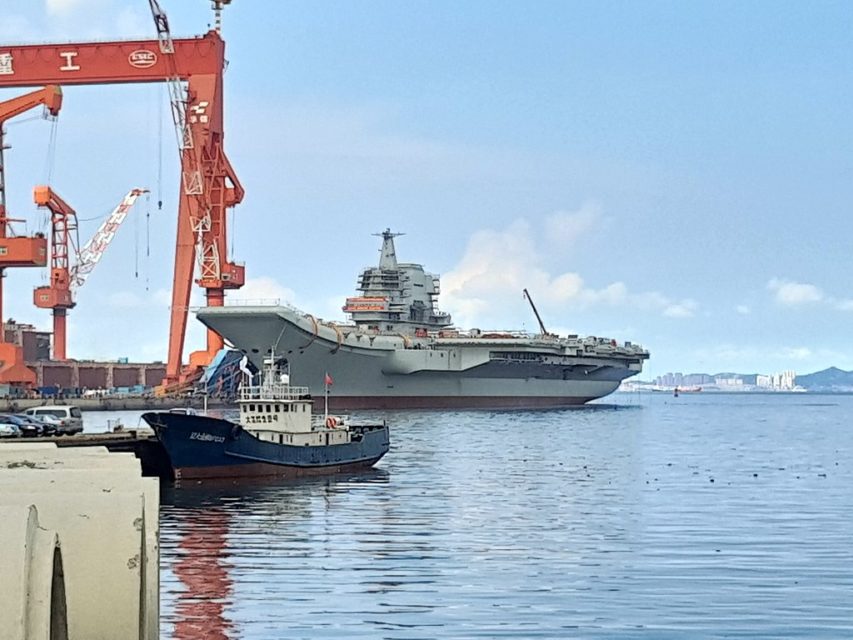Anthony Coleman
Published on 3 Nov 2016From the History Channel DVD series “Great Blunders of WWII”
July 12, 2018
Great Blunders of WWII: Japan’s Mistakes at Midway
June 20, 2018
Korea adds a second helicopter carrier, may adapt them to carry F-35 aircraft
At Strategy Page, a look at the Korean and Japanese helicopter carrier ships, including the recently launched ROKS Marado, the second ship of the Dodko class:
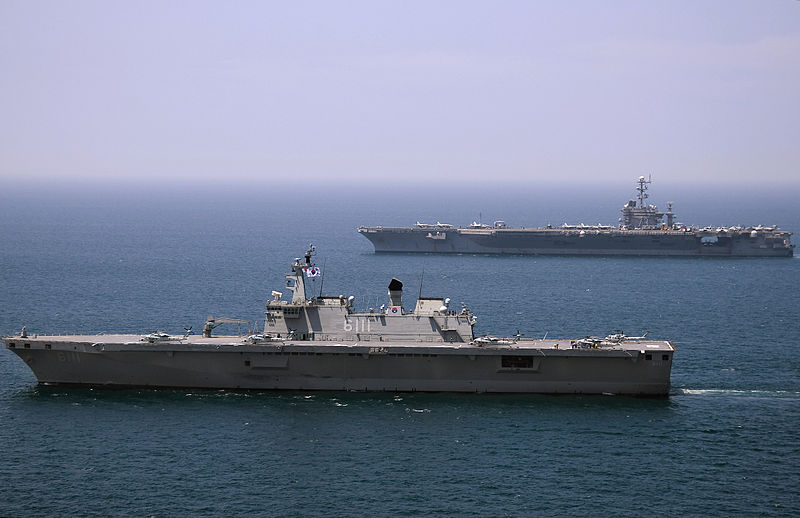
The Republic of Korea Navy amphibious landing ship ROKS Dokdo (LPH 6111) and the aircraft carrier USS George Washington (CVN 73) transit the Sea of Japan (July 27, 2010).
U.S. Navy photo by Mass Communication Specialist 3rd Class Charles Oki via Wikimedia Commons.
During May South Korea launched its second Dokdo class large amphibious ship, the 14,500 ton Marado. The first of these ships, the 14,000 ton LPH (Landing Platform Helicopter) Dokdo entered service in 2007 and the Marado is expected to follow in 2020. In addition to being a bit larger than the first Dokdo, the Marado has a number of new features that enhance its ability to operate as an aircraft carrier. This includes more capable electronics, many of them made in South Korea as well modifications to the flight deck and the hanger deck below.
Both 199 meter long Dokdos are similar in appearance and operation to the larger American amphibious ships. The LPH flight deck can handle helicopters, as well as vertical takeoff jets like the F-35B. The Koreans deny that the ship will be used with these jets, but the capability is there. The LPH normally carries 720 combat troops, a crew of 300, ten tanks, seven amphibious assault vehicle, three towed 155mm howitzers and ten trucks. Dokdos carry fifteen aircraft (two V-22 vertical takeoff transports and 13 helicopters) and two LCAC hovercraft in the well deck for landing troops.
The Marado has a redesigned flight deck that can handle two V-22s at once instead of just one. In addition to a more powerful 3-D surveillance radar for tracking aircraft, Marado has two Phalanx anti-missile systems compared to one Goalkeeper system on Dokdo. South Korea is also going to add a locally developed and manufactured K-SAAM anti-aircraft and anti-missile system. This is similar to the existing U.S. made ESSM but with longer range and an improved guidance system.
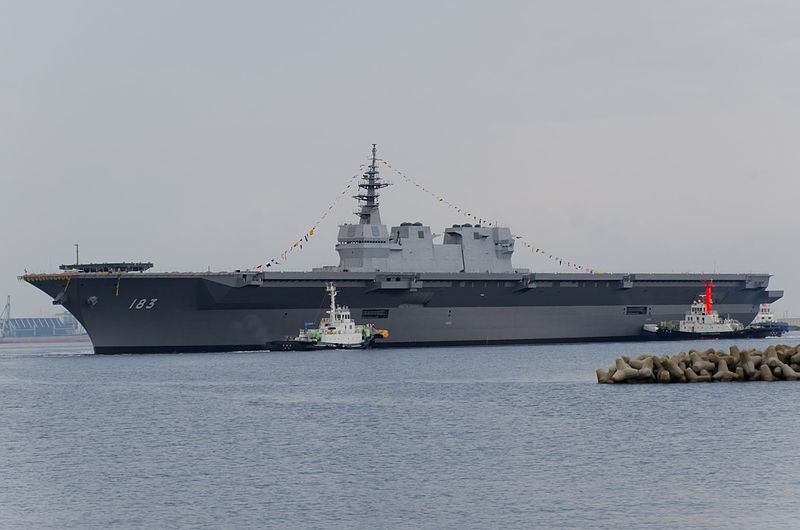
JS Izumo DDH-183, sister-ship of the JS Kaga DDH-184, both helicopter-equipped destroyers, officially.
Meanwhile, neighbor Japan has taken the Dokdo concept a bit farther. In early 2017 Japan put into service a second 27,000 ton “destroyer” (the Kaga, DDH 184) that looks exactly like an aircraft carrier. Actually, it looks like an LPH, an amphibious ship type that first appeared in the 1950s. This was noted when Izumo, the first Japanese LPH, was launched in 2012 (and entered service in 2015). The Izumos can carry up to 28 aircraft and are armed only with two Phalanx anti-missile systems and a launcher with sixteen ESSM missiles for anti-missile and anti-aircraft defense.
[…]
The Izumo is part of a trend. In 2009, Japan launched its second Hyuga class “LPH”. Earlier in 2009, it commissioned the first of these “helicopter-carrying destroyers”. This was the first Japanese aircraft to enter service since 1945. The Hyuga class are 197 meter (610 foot) long, 18,000 ton warships that operates up to eleven (mostly SH-60) helicopters from a full-length flight deck. Although called a destroyer, it very much looks like an aircraft carrier. While its primary function is anti-submarine warfare, the Hyuga will also give Japan its first real power projection capability since 1945. The Hyuga was also the largest warship built in Japan since World War II.
South Korea could adapt their Dokdos to handle a few F-35Bs by making the flight deck more heat resistant and rearranging the hanger deck. South Korea is getting land based F-35As which would enable them to determine if it would be worth the time and money to adapt their LPHs to carry some vertical takeoff F-35Bs. Sometimes peacekeeping missions involve some peacemaking and F-35Bs would help with that.
May 14, 2018
China launches the second Type 001 aircraft carrier (Type 001A)
In the New York Times, Steven Lee Myers reports on the newest People’s Liberation Army Navy (PLAN) aircraft carrier departing from Dalian to undergo its initial sea trials:
China launched its first domestically built aircraft carrier to begin sea trials on Sunday, reaching another milestone in the expansion of the country’s navy.
The aircraft carrier, as yet unnamed, left its berth at a shipyard in the northeastern port of Dalian after a blow of its horn and a display of fireworks, according to reports in state news media.
The Chinese Navy — officially the People’s Liberation Army Navy — already has one operational carrier, the Liaoning, which it bought unfinished from Ukraine after the collapse of the Soviet Union. That ship joined the Chinese fleet in 2012 and began its first operations four years later, putting China in the small group of seafaring powers that maintain aircraft carriers, led by the United States, which has 11.
The Liaoning, which appears to serve as a training vessel as much as a combat ship, was the centerpiece of a naval parade of 48 ships attended last month by China’s leader, Xi Jinping. The following week, it led a carrier battle group in live-fire exercises in the Taiwan Strait and in the East China Sea.
Since taking office, Mr. Xi has driven an ambitious effort to modernize the country’s military, reducing the traditional focus on readying the ground forces of the People’s Liberation Army to defend against an invasion of the mainland and increasing the emphasis on technology-dependent naval, air and missile forces.
The new carrier, built by the Dalian Shipbuilding Industry Company, has a similar design to the Liaoning but has been modified and expanded, according to Chinese and foreign experts.
April 5, 2018
 | Planes of the Graf Zeppelin – Germany’s Aircraft Carrier of World War 2
| Planes of the Graf Zeppelin – Germany’s Aircraft Carrier of World War 2
Bismarck – Military Aviation History
Published on 13 Jul 2017Germany never finished the Graf Zeppelin, an aircraft carrier intended for the Kriegsmarine. But had it done so, these planes would have been part of the likely loadout.
Sources
Breyer, Siegfried; Flugzeugträger Graf Zeppelin
Creek, Eddie J.; Junkers Ju 87 – From Dive-bomber to Tank-Buster 1939 – 1945
Griehl, Manfred; Junkers Ju-87 Stuka – Part 1 – the Early Variants A B C and R of the Luftwaffe
Haynes, Messerschmitt Bf 109 – 1935 onwards (all marks)
Radinger, Willy; Messerschmitt Me 109 – Das meistgebaute Jagdflugzeug der Welt,
Nowarra, Die Deutsche Luftruestung 1933 – 1945
Stammer, Dieter; Stuka Junkers Ju-87 – Das erfolgreichste Sturzkampfflugzeug des Zweiten Weltkriegs
Smith, Peter C.; Stuka Volume One Luftwaffe Ju 87 Dive-Bomber Units 1939-1941
 | Planes of the Graf Zeppelin – Germany’s Aircraft Carrier of World War 2
| Planes of the Graf Zeppelin – Germany’s Aircraft Carrier of World War 2 March 27, 2018
History Buffs: Tora! Tora! Tora!
History Buffs
Published on 21 Jun 2017Tora! Tora! Tora! is a 1970 Japanese-American historical war film that dramatizes the Japanese attack on Pearl Harbor in 1941. The film was directed by Richard Fleischer, Toshio Masuda and Kinji Fukasaku and stars an ensemble cast, including Martin Balsam, Joseph Cotten, Sō Yamamura, E. G. Marshall, James Whitmore and Jason Robards. The title is the Japanese codeword used to indicate that complete surprise had been achieved. “Tora” means “tiger” in Japanese.
Cynical Historian: Pearl Harbor review – https://www.youtube.com/watch?v=oUlwDDeAQNE
March 7, 2018
USS Lexington‘s final resting place discovered by Paul Allen’s RV Petrel
As reported by News Corp Australia:
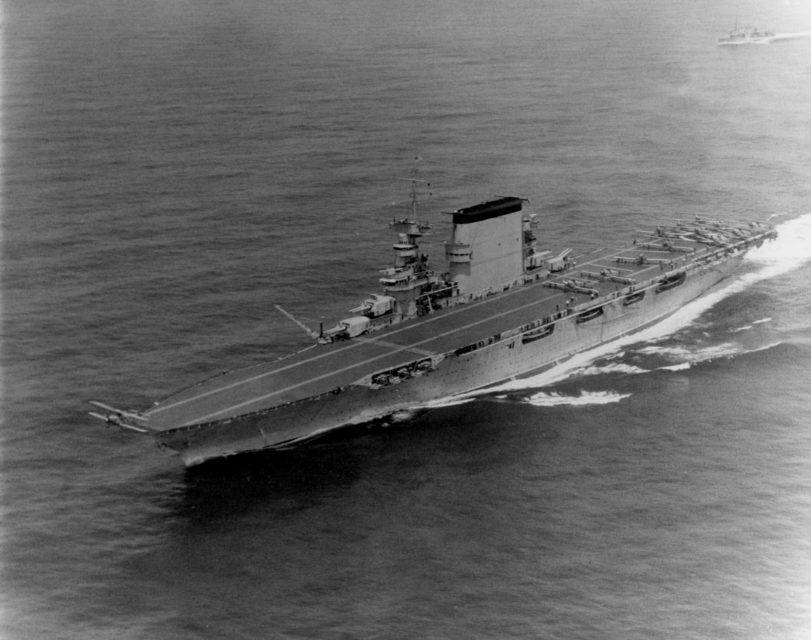
U.S. Navy Martin T4M-1 aircraft of Torpedo Squadron 1B (VT-1B) are launching from the deck of the aircraft carrier USS Lexington (CV-2) in 1931. Note the “four-stacker” (Clemson/Wickes-class destroyer) in the upper right corner.
US Navy photo via Wikimedia.
Now, 76 years after it settled to the bottom, it’s been found.
It’s the latest find by billionaire Paul Allen.
And it’s in a remarkably well preserved condition.
Soon-to-be US ambassador to Australia, US Pacific Commander Admiral Harry Harris says he is elated at the find.
“As the son of a survivor of the USS Lexington, I offer my congratulations to Paul Allen and the expedition crew of Research Vessel Petrel for locating the ‘Lady Lex’,” he said in a tweet.
[…]
Paul Allen’s research vessel Petrel located the wreck of the USS Lexington yesterday.
According to a post on the philanthropist’s website, it rests some 800km off the coast of Queensland at a depth of about 3km.
The find was the result of a six month project.
Photos so far returned by RV Petrel’s submersible show several aircraft that have tumbled out of the carrier and on to the ocean’s floor. Their original markings and paintwork remain remarkably clear.
The ship itself, while showing heavy scarring from the battle and the stresses of diving 3km to the sea floor, is also well preserved. Gun mounts and other fittings show only little sign of corrosion and deterioration.
Vulcan Inc.
Published on 5 Mar 2018Wreckage from the USS Lexington was discovered on March 4, 2018 by the expedition crew of Paul G. Allen’s Research Vessel (R/V) Petrel. The aircraft carrier, “Lady Lex” was found more than 3,000 meters below the surface, resting on the floor of the Coral Sea more than 500 miles off the eastern coast of Australia.
February 2, 2018
Battle: Taranto Raid – Italian Pearl Harbor
Military History Visualized
Published on 20 Jan 2017The British Raid on the Italian Harbor of Taranto in 1940 had a crucial influence on the Japanese Attack on Pearl Harbor. Similarly, it managed to damage several battleships, yet with a far lower strike force. Additionally, the attack was launched during the night.
Military History Visualized provides a series of short narrative and visual presentations like documentaries based on academic literature or sometimes primary sources. Videos are intended as introduction to military history, but also contain a lot of details for history buffs. Since the aim is to keep the episodes short and comprehensive some details are often cut.
January 4, 2018
HMS Ocean to be sold to Brazil
In The Register, Gareth Corfield sums up reports on the disposition of the Royal Navy’s current flagship after a 20-year service life:
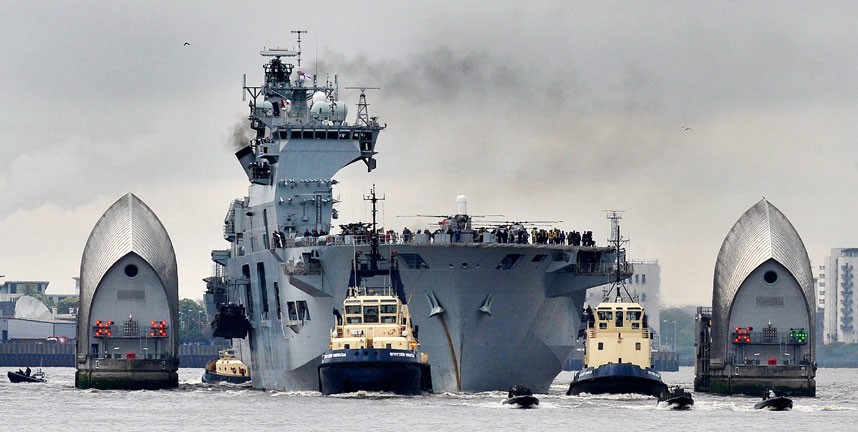
HMS Ocean at the Thames Barrier in 2012, being moved into position to support the Olympic Games in London.
The 22,000-tonne helicopter carrier, which returned from her last British deployment to the Caribbean just weeks ago, will be formally decommissioned from the RN in spring this year.
Although it was well known that Ocean was up for sale and that Brazil (as well as Turkey) were interested in buying the 20-year-old warship, confirmation of the deal and the purchase price were all “known unknowns” until now.
The news was broken by defence blog UK Defence Journal, citing a Brazilian journalist.
The Brazilian Navy’s end-of-year roundup statement, published on Christmas Eve 2017, also included the line: “Minister Raul Jungmann and the Brazilian Navy Commander Eduardo Bacellar Leal Ferreira took the opportunity to announce the purchase of the Royal Navy’s HMS Ocean multifunction vessel, valued at £84m sterling.”
A British Ministry of Defence spokesman told El Reg: “Discussions with Brazil over the long-planned sale of HMS Ocean are at an advanced stage, but no final decisions have been made. HMS Ocean has served admirably with us since 1998 and the revenue she generates will be reinvested in defence as we bolster our Royal Navy with two types of brand new frigates and two huge aircraft carriers.”
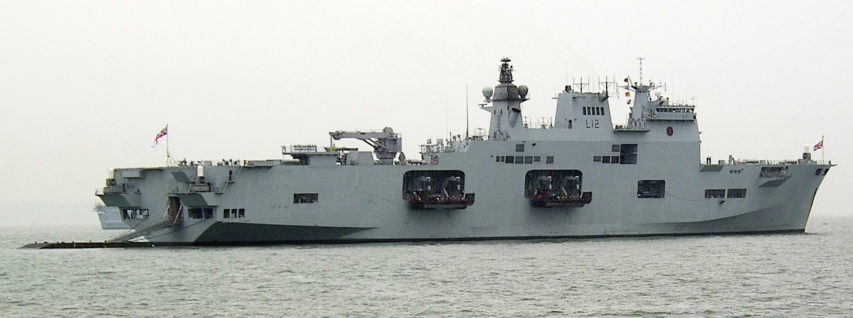
HMS Ocean at the 2005 International Fleet Review, showing Landing Craft on davits and Stern Ramp deployed.
Photo via Wikimedia.
At the Thin Pinstriped Line, Sir Humphrey explains why selling the ship now makes sense for the Royal Navy:
The big change to this requirement came in 2015, when the SDSR [Strategic Defence and Security Review]confirmed that the RN would keep both carriers in active service, and that neither would be CTOL [conventional take-off and landing]. Suddenly the RN found itself planning for a future where it would have two CVF available [the Queen Elizabeth class carriers], both of which would need to have manpower available to crew them. It also meant that the RN could make modifications to the ships to ensure that either of them could operate as an LPH [Landing Platform Helicopter] and carry helicopters and troops as well as a fixed wing airgroup.
This decision has had major ramifications for Ocean – suddenly the need for her to remain in service was gone. The LPH role that she would have done would now be filled by two newer and vastly more capable ships – the UK wasn’t losing capability but gaining it. In practical terms the RN actually would have more chance of an LPH being available without Ocean as CVF availability will be higher, both can role as an LPH (rather than CTOL which would not do this task) and with both platforms active, there is far less chance of the nightmare situation of both the CTOL carrier and the old LPH being stuck in refit at the same time.
From a capability perspective, the move to CVF makes a lot of sense. There are issues to be resolved (arguably the littoral manoeuvre capability offered by her landing craft, the vehicle issue and the question of what to do about afloat 1&2* command platforms and where to put them), but Ocean paying off is not going to remove the LPH capability from the UK toolkit.
The second problem has been that even if the RN wanted to run Ocean on, it has run out of manpower to do so. This year will see Queen Elizabeth at sea doing complex trials, drawing heavily on the Fleet Air Arm personnel to do so. As Prince of Wales (POW) stands up, more and more crew (usually very specialised engineers and the like) will be needed to bring her out of build. On the old plan this wouldn’t have been an issue – one would have gone straight into reserve. Now, the RN has to bring both carriers into service at roughly the same time (a helpful reminder of RN capability here is that it is the only navy in the world currently introducing two supercarriers into service at roughly the same time).
Ocean requires a lot of specialist crew who will be needed on QE and POW, and more importantly so will their reliefs. The manpower planners have not been working on the assumption of three carriers available and at sea (something the RN arguably has not done consistently for many years), and so the manpower structure is not designed to provide this. It could be changed, but would need many years to produce the right numbers of people in the right slots to deliver it without breaking manpower and causing retention challenges.
November 16, 2017
QotD: Carrier cynicism
If you are a follower of UK defence matters, then it seems to be traditional that you must be find a reason, any reason, to naysay and be downbeat about something good. The recent sailing of QUEEN ELIZABETH (QEC, and of course, not yet an HMS), is a good example of this. There were tweets and moans aplenty about an aircraft carrier supposedly without aircraft, about it being empty for years across a barren flight deck with tumbleweed and adrift deck hockey quoits the sole occupants, and of course that’s assuming a 17-year-old hacker hadn’t somehow taken charge of the ship using its SHOCK HORROR Windows XP system that’s not actually connected to the internet to somehow do something bad. This is without mentioning the near orgasmic levels of excitement the media wound themselves up into with the prospect of the vessel running into the side of the dockyard or being stuck under the Forth Bridge.
In reality the opening days of the QE’s sea trials could not have gone better for the Royal Navy and the MOD. An outstandingly effective PR operation managed to secure a great deal of national media coverage of this event, and most of the main papers had photos of the ship at sea. Some highly astute programming ensured that a pair of Type 23 frigates and a pair of Merlin helicopters were immediately available to ostensibly provide cover, but arguably in reality provided the nation with several years of stock footage of British carrier groups at sea. Within a couple of days the first landing was achieved, thus slaying the ‘but she’ll have no aircraft’ argument, and the internet is awash with glorious photos of the biggest warship ever built outside of the United States of America at sea. To top it all off, some sharply pointed jibes towards the Russians by the Secretary of State for Defence managed to elicit a strong reaction, suggesting the Bear is not as thick skinned as it wishes to portray itself to be.
Sir Humphrey, “Some Brief Thoughts on QUEEN ELIZABETH sailing”, Thin Pinstriped Line, 2017-07-03.
August 17, 2017
HMS Queen Elizabeth enters Portsmouth harbour
At The Register, Gareth Corfield reports from Portsmouth as the Royal Navy’s new aircraft carrier HMS Queen Elizabeth visits her new home port for the first time:
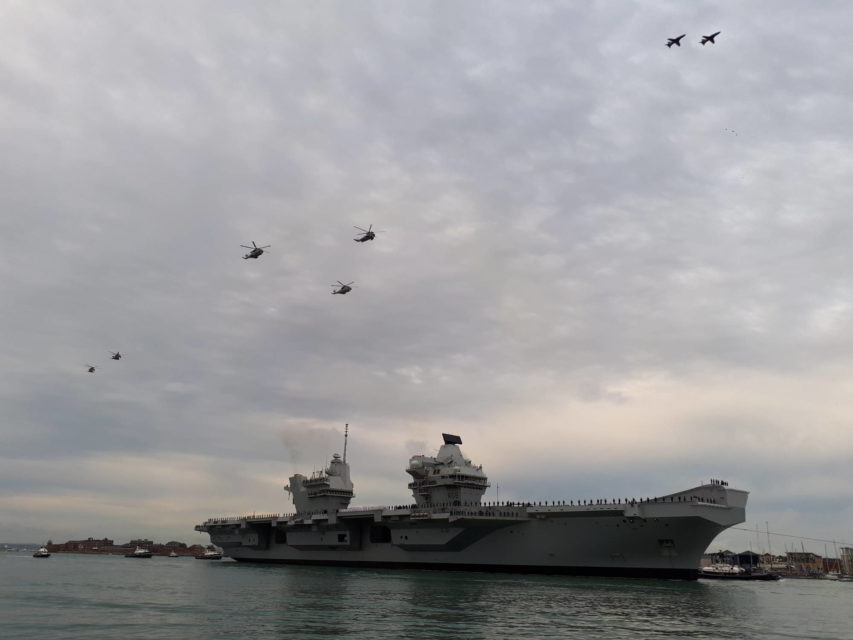
Royal Navy aircraft fly over HMS Queen Elizabeth as she enters Portsmouth harbour. Click to see full-sized photo.
Britain’s newest warship, its biggest warship of all time, HMS Queen Elizabeth, entered Portsmouth Harbour for the first time this morning.
The 65,000-tonne aircraft carrier entered the port at 0710 this morning under the watchful eye of half a dozen tugboats, a small flotilla of police vessels – and crowds of thousands lining the sea front along Portsmouth and Southsea.
In addition, scores of smaller civil vessels accompanied the carrier at a respectful distance. A flypast of Royal Navy helicopters and fast jets – Hawk training aircraft – also took place as the carrier made her stately way towards the naval base.
Admiral Lord West, the former head of the navy and now a Labour Party peer, told The Register as the ship came in: “This is a very joyous day. She looks splendid. We had lost sight of our maritime capability. This is something very special for Portsmouth and the Navy.”
When asked if the Queen Elizabeth-class carriers were necessary, the admiral said: “The one thing you can’t guarantee is what will happen tomorrow. When they’ve got their fixed wing assets, they’ll be one of the only capabilities [the UK has that will have] a strategic impact. It’s 4.5 acres of British sovereign territory.”
July 1, 2017
Hunting the Bismarck – III: A Chance to Strike – Extra History
Published on May 25, 2017
Sponsored by Wargaming! New players: Download World of Warships and use the code EXTRA1 for free goodies! http://cpm.wargaming.net/i3v7c6uu/?pu…
The order went out: Sink the Bismarck. Ships converged from all over the Atlantic to hunt down the pride of the German navy, and Swordfish planes launched from the aircraft carrier Ark Royal raced to harry the great warship.
June 4, 2017
The Battle of Midway, 4-7 June 1942
Last month, Victor Davis Hanson recounted the American side of the Battle of Midway, which many historians see as the turning point of the Pacific War:

Battle of Midway deployment map, according to Seeschlachten der Weltgeschichte by William Koenig (German version of Epic Sea Battles) via Wikimedia
Seventy-five years ago (June 4-7, 1942), the astonishing American victory at the Battle of Midway changed the course of the Pacific War.
Just six months after the catastrophic Japanese surprise attack on Pearl Harbor, the U.S. crushed the Imperial Japanese Navy off Midway Island (about 1,300 miles northwest of Honolulu), sinking four of its aircraft carriers.
“Midway” referred to the small atoll roughly halfway between North America and Asia. But to Americans, “Midway” became a barometer of military progress. Just half a year after being surprised at Pearl Harbor, the U.S. Navy had already destroyed almost half of Japan’s existing carrier strength (after achieving a standoff at the Battle of the Coral Sea a month earlier).
The odds at the June 1942 battle favored the Japanese. The imperial fleet had four carriers to the Americans’ three, backed up by scores of battleships, cruisers and light carriers as part of the largest armada that had ever steamed from Japan.
No military had ever won more territory in six months than had Japan. Its Pacific Empire ranged from the Indian Ocean to the coast of the Aleutian Islands, and from the Russian-Manchurian border to Wake Island in the Pacific.
Yet the Japanese Navy was roundly defeated by an outnumbered and inexperienced American fleet at Midway. Why and how?
March 30, 2017
Another Japanese “destroyer” joins the fleet
Due to a long-standing aversion to calling certain kinds of vessels by their most appropriate name, the Japanese Maritime Self-Defence Force (because Japan’s constitution prohibits the country having a “navy”, post-1945) commissioned their latest “destroyer” last week:

JS Izumo DDH-183, sister-ship of the just-commisioned JS Kaga DDH-184, both helicopter-equipped destroyers, officially.
I know what you’re thinking … “That doesn’t look like a destroyer to me” … but that’s what Japan officially designates ships like this to be, so that’s what they’re called. Strategy Page has more:
On March 22nd Japan put into service a second 27,000 ton “destroyer” (the Kaga, DDH 184) that looks exactly like an aircraft carrier. Actually it looks like an LPH (Landing Platform Helicopter) an amphibious ship type that first appeared in the 1950s. This was noted when Izumo, the first Japanese LPH was launched in 2012 (it entered service in 2015). The Izumos can carry up to 28 aircraft and are armed only with two 20mm Phalanx anti-missile cannon and launcher with sixteen ESSM missiles for anti-missile defense.
LPHs had no (or relatively few) landing craft but did carry a thousand or more troops who were moved ashore using the dozen or more helicopters carried. The first American LPH (the USS Iwo Jima) was an 18,400 ton ship that entered service in 1961, and carried 2,000 troops and twenty-five helicopters. Until Izumo showed up, several nations operated LPHs, and Britain and South Korea still do. The U.S. retired its last LPHs in the 1990s, but still have a dozen similar ships that include landing craft (and a well deck in the rear to float them out of) as well as helicopters. A few other nations have small carriers that mostly operate helicopters but carry few, if any troops.
The Izumos are the largest LPHs to ever to enter service. It differs from previous LPHs in not having accommodations for lots of troops and having more powerful engines (capable of destroyer-like speeds of over fifty-four kilometers an hour). Izumo does have considerable cargo capacity, which is intended for moving disaster relief supplies quickly to where they are needed. Apparently some of these cargo spaces can be converted to berthing spaces for troops, disaster relief personnel, or people rescued from disasters. There are also more medical facilities than one would expect for a ship of this size. More worrisome (to the Chinese) is the fact that the Izumo could carry and operate the vertical take-off F-35B stealth fighter, although Japan has made no mention of buying that aircraft or modifying the LPH flight decks to handle the very high temperatures generated by the F-35B when taking off or landing vertically. The Chinese are also upset with the name of this new destroyer. Izumo was the name of a Japanese cruiser that was a third the size of the new “destroyer” and led the naval portion of a 1937 operation against Shanghai that left over two-hundred-thousand Chinese dead. The Chinese remember all this, especially the war with Japan that began unofficially in 1931 and officially in 1937.
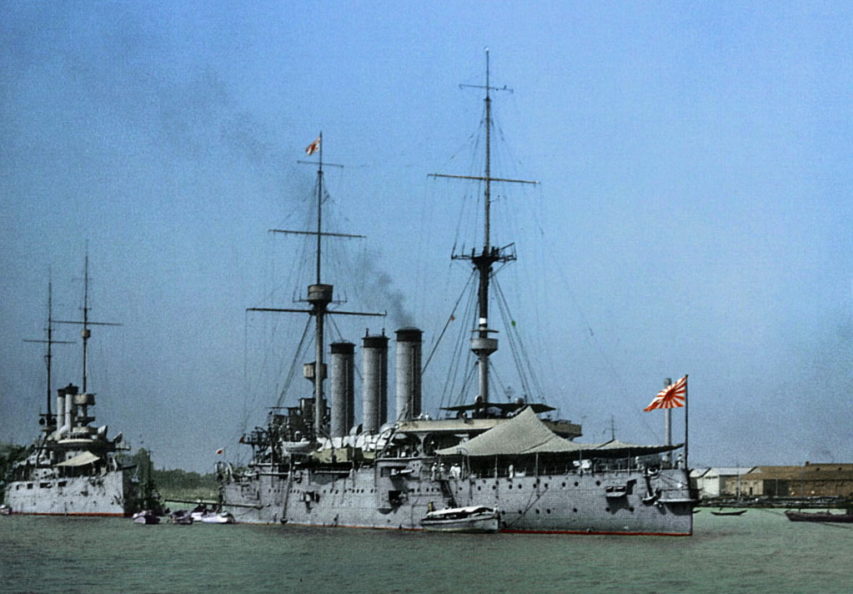
IJNS Izumo at anchor 1932 (Colourized), via Wikimedia
February 21, 2017
HMS Queen Elizabeth to be commissioned in May
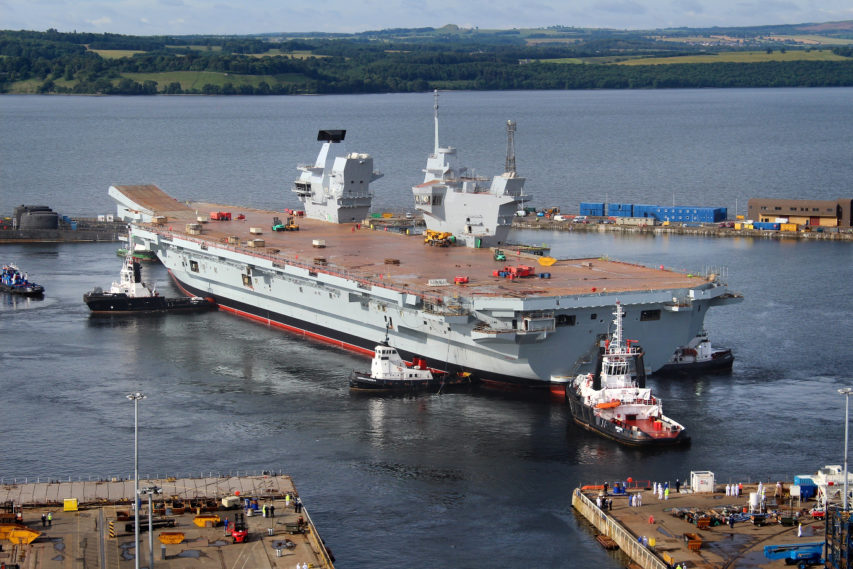
The Royal Navy’s largest ever warship HMS Queen Elizabeth is gently floated out of her dock for the first time in Rosyth, Scotland in July 2014. In an operation that started earlier that week, the dry dock in Rosyth near Edinburgh was flooded for the first time to allow the 65,000 tonne aircraft carrier to float. It then took only three hours to carefully manoeuvre HMS Queen Elizabeth out of the dock with just two metres clearance at either side and then berth her alongside a nearby jetty. Teams continued to outfit the ship and steadily bring her systems to life in preparation for sea trials in 2016. The dock she vacated will be used for final assembly of her sister ship, HMS Prince of Wales.
Source: Wikimedia.
The Royal Navy’s newest aircraft carrier is scheduled to be brought into commission in May this year:
The first new Royal Navy aircraft carrier in thirty years is nearing sea trials. After a brief absence from the world of fixed-wing naval aviation the Royal Navy’s brand new flattop HMS Queen Elizabeth and its sister ship, Prince of Wales, will soon sail the seas, their decks full of new F-35 Joint Strike Fighters. The result will be the most powerful “Senior Service” in generations.
The Royal Navy was one of the first naval warfare forces to explore the nascent world of naval aviation. HMS Argus, commissioned in September 1918, was arguably the first aircraft carrier with a full-length flight deck. The UK was one of the major aircraft carrier powers throughout World War II, and continued to operate carriers in the postwar period.
By 1982, the Royal Navy had committed to building three Invincible-class carriers. Somewhat scaled back from earlier ships, and dwarfed by the U.S. Navy’s Nimitz-class carriers, the Invincible class was more suited to antisubmarine warfare duties against the Soviet Navy, keeping the sea lines of communication between North America and Europe clear in the event of World War III. The Invincibles could sail with a complement of up to twenty-two aircraft, typically a mixture of Sea Harrier fighters and Sea King helicopters.
The 1982 Falklands War demonstrated the shortcomings of relying upon such small carriers. HMS Invincible, along with the older HMS Hermes, struggled to provide early warning and combat air patrol over the UK task force sent to reclaim the islands, and were unable to prevent Argentine air power from sinking six friendly warships and supply ships and damaging another nine.
In 2007, despite the general downturn in the size and scope of the navy, plans were announced in 2007 to construct two brand-new aircraft carriers. Each would be stocked with brand-new F-35 Joint Strike Fighters and helicopters, and would be up more than three times larger than their predecessors by displacement. The carriers, Queen Elizabeth and Prince of Wales, would be the largest warships ever built by the UK, bigger even than the World War II battleship HMS Vanguard.
Unfortunately, in order to free up funding for the new carriers the older ships had to be retired, and decommissioning of the Invincible class carriers and their Sea Harrier jets during the 2010s was a huge blow to the Fleet Air Arm. The three warships were broken up for scrap, and the remaining Harrier jets, which by now included RAF Harriers, were purchased by the U.S. Marines to provide spare parts for their own fleet of AV-8B Harriers.

